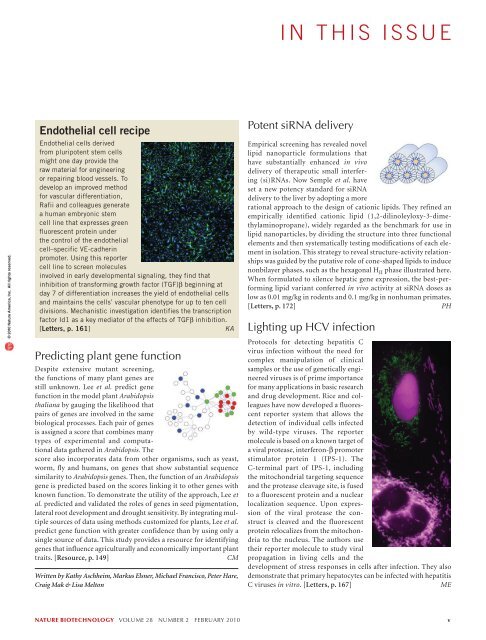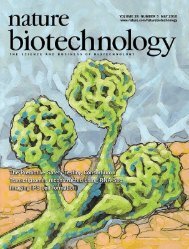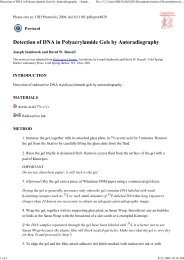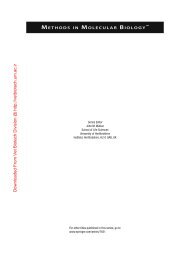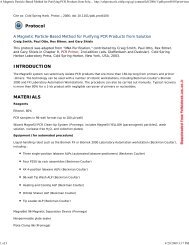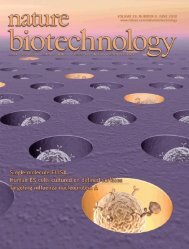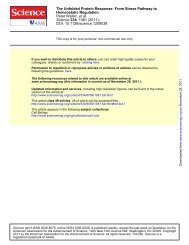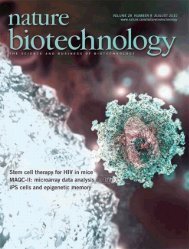Ontology engineering
Ontology engineering
Ontology engineering
Create successful ePaper yourself
Turn your PDF publications into a flip-book with our unique Google optimized e-Paper software.
in this issue© 2010 Nature America, Inc. All rights reserved.Endothelial cell recipeEndothelial cells derivedfrom pluripotent stem cellsmight one day provide theraw material for <strong>engineering</strong>or repairing blood vessels. Todevelop an improved methodfor vascular differentiation,Rafii and colleagues generatea human embryonic stemcell line that expresses greenfluorescent protein underthe control of the endothelialcell–specific VE-cadherinpromoter. Using this reportercell line to screen moleculesinvolved in early developmental signaling, they find thatinhibition of transforming growth factor (TGF)β beginning atday 7 of differentiation increases the yield of endothelial cellsand maintains the cells’ vascular phenotype for up to ten celldivisions. Mechanistic investigation identifies the transcriptionfactor Id1 as a key mediator of the effects of TGFβ inhibition.[Letters, p. 161]KAPredicting plant gene functionDespite extensive mutant screening,the functions of many plant genes arestill unknown. Lee et al. predict genefunction in the model plant Arabidopsisthaliana by gauging the likelihood thatpairs of genes are involved in the samebiological processes. Each pair of genesis assigned a score that combines manytypes of experimental and computationaldata gathered in Arabidopsis. Thescore also incorporates data from other organisms, such as yeast,worm, fly and humans, on genes that show substantial sequencesimilarity to Arabidopsis genes. Then, the function of an Arabidopsisgene is predicted based on the scores linking it to other genes withknown function. To demonstrate the utility of the approach, Lee etal. predicted and validated the roles of genes in seed pigmentation,lateral root development and drought sensitivity. By integrating multiplesources of data using methods customized for plants, Lee et al.predict gene function with greater confidence than by using only asingle source of data. This study provides a resource for identifyinggenes that influence agriculturally and economically important planttraits. [Resource, p. 149]CMWritten by Kathy Aschheim, Markus Elsner, Michael Francisco, Peter Hare,Craig Mak & Lisa MeltonPotent siRNA deliveryEmpirical screening has revealed novellipid nanoparticle formulations thathave substantially enhanced in vivodelivery of therapeutic small interfering(si)RNAs. Now Semple et al. haveset a new potency standard for siRNAdelivery to the liver by adopting a morerational approach to the design of cationic lipids. They refined anempirically identified cationic lipid (1,2-dilinoleyloxy-3-dimethylaminopropane),widely regarded as the benchmark for use inlipid nanoparticles, by dividing the structure into three functionalelements and then systematically testing modifications of each elementin isolation. This strategy to reveal structure-activity relationshipswas guided by the putative role of cone-shaped lipids to inducenonbilayer phases, such as the hexagonal H II phase illustrated here.When formulated to silence hepatic gene expression, the best-performinglipid variant conferred in vivo activity at siRNA doses aslow as 0.01 mg/kg in rodents and 0.1 mg/kg in nonhuman primates.[Letters, p. 172]PHLighting up HCV infectionProtocols for detecting hepatitis Cvirus infection without the need forcomplex manipulation of clinicalsamples or the use of genetically engineeredviruses is of prime importancefor many applications in basic researchand drug development. Rice and colleagueshave now developed a fluorescentreporter system that allows thedetection of individual cells infectedby wild-type viruses. The reportermolecule is based on a known target ofa viral protease, interferon-β promoterstimulator protein 1 (IPS-1). TheC-terminal part of IPS-1, includingthe mitochondrial targeting sequenceand the protease cleavage site, is fusedto a fluorescent protein and a nuclearlocalization sequence. Upon expressionof the viral protease the constructis cleaved and the fluorescentprotein relocalizes from the mitochondriato the nucleus. The authors usetheir reporter molecule to study viralpropagation in living cells and thedevelopment of stress responses in cells after infection. They alsodemonstrate that primary hepatocytes can be infected with hepatitisC viruses in vitro. [Letters, p. 167]MEnature biotechnology volume 28 number 2 february 2010v


